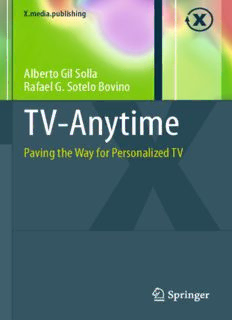Table Of ContentX.media.publishing
Alberto Gil Solla
Rafael G. Sotelo Bovino
TV-Anytime
Paving the Way for Personalized TV
Forfurthervolumes:
http://www.springer.com/series/5175
ThiSisaFMBlankPage
Alberto Gil Solla (cid:129) Rafael G. Sotelo Bovino
TV-Anytime
Paving the Way for Personalized TV
AlbertoGilSolla RafaelG.SoteloBovino
UniversityofVigo UniversidaddeMontevideo
Vigo Montevideo
Spain Uruguay
ISSN1612-1449 X.media.publishing
ISBN978-3-642-36765-6 ISBN978-3-642-36766-3(eBook)
DOI10.1007/978-3-642-36766-3
SpringerHeidelbergNewYorkDordrechtLondon
LibraryofCongressControlNumber:2013939978
ACMComputingClassification(1998):H.5,H.3,C.3,I.3
#Springer-VerlagBerlinHeidelberg2013
#2012byAndaviraEditora,SantiagodeCompostela,Spain.
TitleoftheSpanishoriginal:
TV-Anytime:HaciaunaTVpersonalizada
Thisworkissubjecttocopyright.AllrightsarereservedbythePublisher,whetherthewholeorpartof
the material is concerned, specifically the rights of translation, reprinting, reuse of illustrations,
recitation,broadcasting,reproductiononmicrofilmsorinanyotherphysicalway,andtransmissionor
informationstorageandretrieval,electronicadaptation,computersoftware,orbysimilarordissimilar
methodologynowknownorhereafterdeveloped.Exemptedfromthislegalreservationarebriefexcerpts
inconnectionwithreviewsorscholarlyanalysisormaterialsuppliedspecificallyforthepurposeofbeing
enteredandexecutedonacomputersystem,forexclusiveusebythepurchaserofthework.Duplication
ofthispublicationorpartsthereofispermittedonlyundertheprovisionsoftheCopyrightLawofthe
Publisher’s location, in its current version, and permission for use must always be obtained from
Springer.PermissionsforusemaybeobtainedthroughRightsLinkattheCopyrightClearanceCenter.
ViolationsareliabletoprosecutionundertherespectiveCopyrightLaw.
The use of general descriptive names, registered names, trademarks, service marks, etc. in this
publicationdoesnotimply,evenintheabsenceofaspecificstatement,thatsuchnamesareexempt
fromtherelevantprotectivelawsandregulationsandthereforefreeforgeneraluse.
While the advice and information in this book are believed to be true and accurate at the date of
publication,neithertheauthorsnortheeditorsnorthepublishercanacceptanylegalresponsibilityfor
anyerrorsoromissionsthatmaybemade.Thepublishermakesnowarranty,expressorimplied,with
respecttothematerialcontainedherein.
Printedonacid-freepaper
SpringerispartofSpringerScience+BusinessMedia(www.springer.com)
To our families
ThiSisaFMBlankPage
Preface
Televisionisamaturemassmediathathasbeenaroundfor55yearsinSpainand
Uruguay,whileithasnowbeenclosetoeightdecadesofregularbroadcastssince
itsbeginningsintheUKandtheUSA.
Spurred by the spectacular growth of the Internet and social networks, it has
becomemoreandmorefrequentinrecenttimestoheartheechoofcriticalvoices
that question both the impact of television on new generations and the future
projectionofitsinfluenceinsociety.However,thedeclineoftheinfluencetelevi-
sionstillexertsonmostofthepopulationisaconjectureallthesame,supportedby
scantstudiesandwithoutimportantnumberstorelyon.Televisioninfactremains
the leading channel for entertainment and information in any developed society,
exertinganunparalleledinfluenceonpublicopinion.
What is clear is that television has been, until recently, a media phenomenon
witharatherslowevolutionregardingtheinteractionwithitsusers,andthatthisis
beginningtochange.Untilnow,viewershistoricallylimiteditsusetothereception
and playback of images complemented in many cases by the latest capability to
record contents. The digital transition has rushed things, and the computational
capacityoftelevisionsandset-topboxeshasincreasedthepossibilitiesofcommu-
nicationandimplementationofservicesoftheusers’equipment.
Buttousethisprocessingcapacityeffectivelyandelevatethediscreteimprove-
mentsweareexperiencingtodaytothecategoryofrevolution,itisnecessaryforthe
software that provides intelligence to have within its reach information it can
manipulate and understand, and not only signals to reproduce. It is essential to
characterize the environment (content, users, devices, etc.) by means of formal
descriptions,onwhichitispossibletoapplythecomparisonandreasoningprocesses
that allow the software to identify the most attractive contents for each user and
properlyresolveanyissuessothattheycanbeaccessedtransparently.
Atthesametime,topromoteeconomiesofscalethatgiveawell-foundedhope
of recovering the necessary investments, it is essential to ensure interoperability
betweenequipments(whichentailssharingofinformationformatsandprotocols).
By doing this, users can purchase equipment with the assurance that they will be
vii
viii Preface
abletohaveuniversalaccesstotheservicesprovidedbyoperatorsorthirdparties,
andnotjusttonichesartificiallyestablishedbytheinitiativesofmanufacturers or
TVplatforms.
Thisbookprovidesageneralintroductiontotheresourcesandcapabilitiesofthe
TV-Anytimestandard,aregulatingeffortthatisaimedatmakingahomogenizing
proposal for certain informationformats and communicationprotocols to create a
frameworkonwhichtoeasilydeveloptheintelligentservicesthatarecominginto
the audiovisual market. The purpose of this standard is toachieve a consensus on
theformatsoftheinformationthatmustfeedthereasoningprocessesinherenttoan
intelligentsystem,therebyensuringmanufacturersandcreatorsthattheirproducts
willaspiretothewidestpossiblemarket, withoutfearofbeingconstrainedbythe
warsofinteresttypicalforemergingtechnologies.
Throughoutthebook,thesuccessivechaptersprovideadetailedrevisionofthe
most important contributions of the standard. To start with, Chap. 1 focuses on
the actual state and future trends of the television industry and on the vision and
structureoftheTV-Anytimestandard.Then,Chap.2presentsageneraloutlineof
the standard, showing the logical architecture of a possible platform that deploys
TV-Anytimeservicesanddescribingthemainelementsinvolved,togetherwiththe
informationtheyhandle.Itcanbeconsidered,partly,asummaryofthebook,where
the contents of the following chapters are presented to get a general overview of
theirrelationships.
Thenextchapterspresentthemaintoolsprovidedbythestandard.Chapter3is
devotedtothemechanismdefinedinTV-Anytimefortheunambiguousreferenceto
contentsandtheresolutionofsuchreferencestogetlocatorsthatmakeitpossibleto
acquirethecontents.Chapter4isentirelyfocusedonthedescriptionofmetadata,
whichisstandardizedtodescribeaudiovisualcontents.
After introducing the main tools, several frameworks to support advanced
audiovisual services are covered. Chapter 5 presents different elements and
procedurestoimplementcustomizedsmartservicesrelatedtoaudiovisualcontents:
features to manage the customization processes, mechanisms for the dynamic
substitution of advertisements, and a coupon system to promote offers related to
the announced contents or products. Following this, Chap. 6 deals with content
packaging, a procedure to group and coordinate many contents aimed at being
consumedinajointandsynchronizedway.
Chapter7dealswithdifferentaspectsofthedeliveryofTV-Anytimemetadata
inunidirectionalcontexts,atthedestination.
The last chapters are devoted to issues related with the communication of
TV-Anytimedeviceswiththeoutsideworld.Chapter8dealswiththecharacteristics
ofcommunicationwithexternalservicesthatprovidemetadata,whichareaccessible
throughbidirectionalnetworks,andtheproceduresforsharinguserprofiles.Chapter9
coverstheremoteprogrammingofareceiver(whichbelongstoauserortoaservice
providedbythirdparties)andtheformatsofinformationexchangewithapplications
thatdonotmeettheTV-Anytimeregulations.Finally,Chap.10closesthebookwith
briefconclusions.
Preface ix
This book is not a reference manual of the standard, and it does not contain
complete and thorough descriptions of all aspects covered in the TV-Anytime
specifications(unapproachablebecauseofitslengthandinadvisable—inaninfor-
mativeworksuchasthisone—becauseofthethoroughnessthatwouldberequired).
Itssolepurposeistoarousethereader’scuriosityaboutthepromisingcapabilities
of this initiative, provide a brief description of the mechanisms and elements
involved, and present simple examples to clarify what is described and to show
itsscope.Wehopethatthisbookhelpsreadersresolvetheirdoubtswithrespectto
possible projects, or at least gain a more accurate vision of what the future may
holdfortheminthisscenery.
Description:Television is a mature mass media with close to eight decades of regular broadcasts since its beginnings in Germany, the UK and the USA. Today, despite the spectacular growth of the Internet and social networks, television is still the leading medium for entertainment and information across the worl

